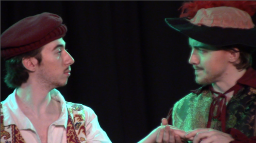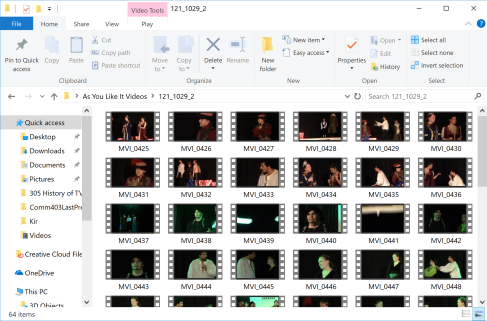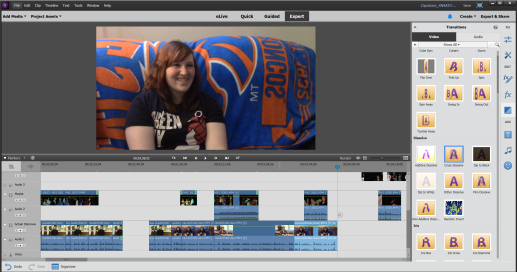
Students checking out bulletin boards on the Shepherd University campus inevitably come across posters announcing auditions for one of Shakespeare’s plays. Anyone passing by Reynolds Hall on the way in to town has at some point encountered a sandwich board on the sidewalk, plastered with performance dates and photos of actors in feathered caps and period costumes.
These traditional advertising props provide the practical details for auditions and performances, but even the most dramatic pictures never seemed to fully capture the essence of the group performing them – and it’s the character and charisma of the Rude Mechanicals that makes their performances so fun and inviting. Shakespeare dramas, historic Greek works like Antigone, Medea and Electra, and contemporary plays written by Shepherd students come to life at these actors’ hands, in a way that makes them accessible and relevant to modern audiences.
My video project, Cue The Lights, was born out of my own transformative experiences over four years with the Rudes. My goal was to give the Shepherd community a closer look at their resident historical-theater troupe, raising awareness of their friendly, inclusive nature and willingness to bring anyone who shows interest into their circle of comradery.
Concept:
In return for giving me a place to express myself and a circle of close friends, I wanted to give the Rudes something multi-functional that they could use both online and in the theater to capture attention, promote audition opportunities and performances, and take with them on the road to theater festivals. I didn’t want to create just another static poster of performers in period costumes; I wanted to go deeper and show people the real Rudes in motion on the stage – and behind it.
I decided to film a mini-documentary that would contain “sub- videos” within it. The project could be broken down into shorter, catchier pieces for different purposes – a-one minute clip for advertising auditions, a slightly longer three-minute version for promoting the group for performances, and the full 12-minute film to stand as a biopic of the Rudes themselves. I knew I wanted to focus heavily on interviews, because it was important to let my castmates share their thoughts on the whole theater process – as opposed to just having one voice talk about the group without truly demonstrating the enthusiasm & comradery I’d experienced and wanted to portray.
Ever since taking Studio Production, I had been looking for a chance to practice and improve my skills in capturing and editing video, and this seemed like a perfect opportunity to do just that. I watched short documentaries such as Glacier Exit and Motion/Static for inspiration. I didn’t have anything close to the same budget or production quality as these films, but hoped to learn to capture their editing style (particularly in the use of transitions between clips), their ability to capture and sustain attention, and the way they perfectly cued clips to the background music in order to set the mood and draw the viewer in.
Process
I started out by attending rehearsals of As You Like It and recording as much B-roll footage as I possibly could. This process lasted as long as rehearsals did (about 3 months) and resulted in a healthy 2-hour pool of footage to sift through.

Then came the interviews. I wrote simple questions, asked my castmates if any of them would like to be interviewed and appear in the video, figured out dates and times for to meet up with those who responded, and filmed them over the course of a few weeks.
I watched the interviews again, selected the clips that I wanted to use, and isolated them in Adobe Premiere Elements Plus 15. I transcribed these in Notepad to make them quicker to organize, and arranged them into five topically-related segments to create the backbone of the video. I then wrote a script for the narration, tailoring it to match the contents of the interviews, and recorded the narration (with the help of cast member Dylan Kontra, who kindly lended his voice).
I sought out royalty-free music to use in the background, and then came the most complicated part: assembling and editing the video. First, I arranged the audio elements (music, narration, and interviews) in a pattern that made sense, creating the final backbone of the video. I searched through my pool of B-roll footage to find suitable clips to lay over the narration, imported them into Premiere Elements, dragged them into their places, and cut them to the proper length. I constructed an intro and outro, added text, and made minor color and audio edits to individual clips. I did some last-minute polishing and ran the video by a test audience to make sure everything ran smoothly.

The final step was rendering and uploading the video, and then the project was done.
The Final Product:
The project ended up being a 12-minute-long, documentary-style promotional video. It features both rehearsal and performance clips shot over a period of three months from the Rudes’ 2018 production of As You Like It, as well as interviews with cast members and comments by Dr. Betty Ellzey. I have yet to divide it into the shorter “sub-videos” that can be used for broader advertising purposes, but that should be a quick process that I can easily finish before the next Rudes production starts.
Creating Cue the Lights! was an intense and sometimes nerve wracking process, but I think that in the end I achieved what I set out to do. I gave the Rudes something they could show to prospective members to generate interest (as well as something for my castmates to remember their performance by), and I learned a good bit about video editing in the process. I still have much to learn about audio editing and camera operation, but those will come with time and practice. I sincerely hope I have the opportunity to pursue more video work in the future!
